Although more than a decade has passed since the launch of the Maltese Falcon, this yacht still attracts the most attention.
History of creation
The yacht was built in 2006 at the Italian shipyard Perini Navy, which is going through hard times today. The Falcon was commissioned by American businessman Tom Perkins, who wanted a large sailing yacht. Legend has it that when the first project was presented to him, the customer was horrified by the amount of rigging required and how much it cluttered up all the free space on the upper deck. Shipbuilders thought about how to solve this problem and remembered the DynaRig sailing rig, developed by the German engineer Wilhelm Prelss back in the 60s of the 20th century.
Initially, the DynaRig armament was intended exclusively for large-capacity cargo ships, the main idea was that it would allow significant fuel savings on long-distance crossings. The main feature of DynaRig is that the sails are removed not to the yards, but to the mast itself, thanks to which you can do without running and standing rigging and fully automate the controls, reducing the size of the team. At the same time, the masts themselves are movable, so that the sails can be set at different angles to the wind.
Prelss patented his creation and even managed to create a company that was supposed to popularize DynaRig. But the revival of the cargo sailing fleet did not take place. And although the energy crisis of the 70s of the last century aroused some interest in this type of sailing rig, it never became popular. The technologies of that time did not allow creating a really convenient and reliable solution.
The main problem with DynaRig is the complexity of implementation. And it is not surprising that many dissuaded Perkins from such an unusual step. But being a venture capitalist, he was used to taking risks and decided to try. As a result, the most unusual yacht at the time of launching was born, disputes about the merits and demerits of which do not subside to this day. Fans of the latest technology have always been delighted with her. Fans of the same traditional approaches "Falcon" has always caused only ridicule.
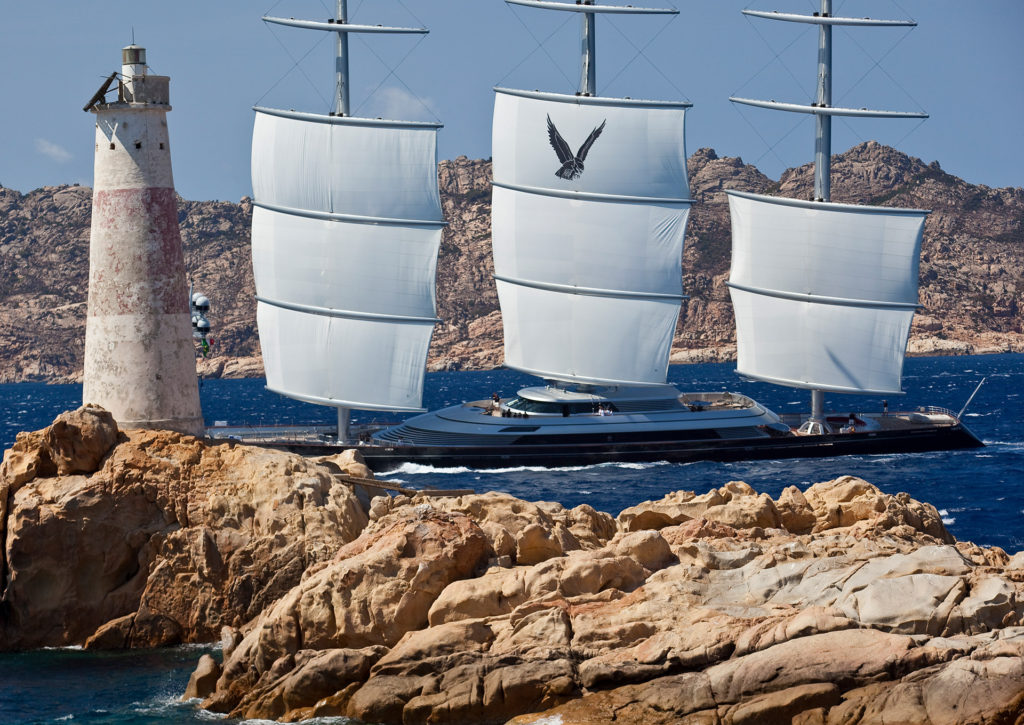
It is not known for certain how much the construction of the Maltese Falcon cost. Amounts from 150 to 300 million dollars are called, but all this is nothing more than speculation. The yacht got its name in honor of the true classic of American cinema - the film "The Maltese Falcon", filmed in 1941 and based on the novel of the same name by the famous author of detectives Dashiell Hammett.
It must be said that formally the construction of the Sokol began back in 1989, initially it was an ordinary sailing yacht (albeit a very large one). But the customer could not pay for its construction, and the almost finished hull “gathered dust” at the shipyard in Tuzla for almost a decade, until Perkins appeared with his unusual ideas.
Technical side of the project
The DynaRig sailing rig was designed for very large ships and it turned out to be a very difficult task to “squeeze” it onto the board of a yacht, even if it had a length of 88 meters, which was entrusted to the Dutch company Gerard Diikstra & Partners. Literally everything had to be revised, a lot of people from various companies worked on the project, who had to solve a lot of unusual engineering issues. But the result was worth it!
Three carbon fiber masts, 1.3 meters thick at the base, carry 15 sails, with a total area of 2400 sq.m.
Tens of thousands of man-hours were spent on the creation of the sailing system, several models of the yacht were created for its testing, and the largest of them had a length of 15 meters and was radio-controlled. Three carbon fiber masts, 1.3 meters thick at the base, are made by the British company Insensys, Ltd. They carry 15 sails with a total area of 2400 sq.m. At the same time, due to the absence of gaps, the sails on each mast act as a single aerodynamic wing, for the full disclosure of which 6 minutes are enough. When folded, the sails are hidden in the mast itself, from which they extend in the manner of a curtain. By the way, it was the unusual arrangement of the sails that at one time caused a lot of controversy, many doubted the reliability of hollow masts.
Everything is automated as much as possible, thanks to the most complex electronic system, only one person is enough to control the yacht. A special computer system is responsible for the coordinated work of all equipment, and Perkins later claimed that he personally wrote part of the necessary code for it. All sorts of sensors are literally “stumbled” everywhere, monitoring various indicators and sensitively responding to their slightest changes. And the control panel on the bridge looks like it was borrowed from a spaceship.
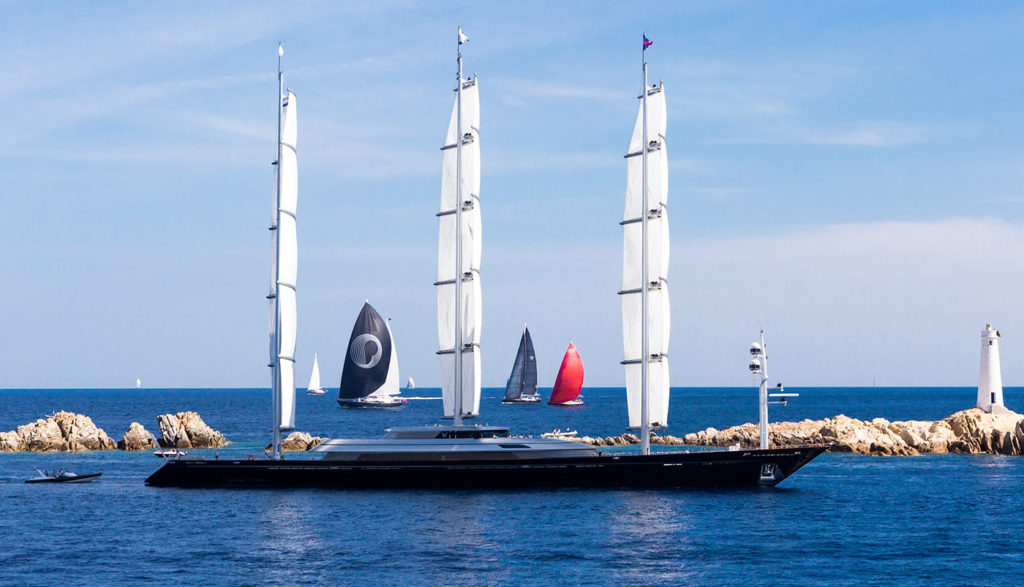
And here we are faced with what causes the most discussion. The fact is that impressive electric motors powered by diesel generators are used to control the masts. In other words, even when sailing, the yacht actively consumes fuel, which is the reason for ironic remarks from lovers of classic sailboats. Naturally, there is no question of any environmental cleanliness of a traditional sailing vessel.
As for the maximum speed, it is claimed that once the Falcon managed to develop 20 knots while sailing. But this information seems unreliable to some experts, they argue that the figure was overestimated in order to draw additional attention to the yacht.
In addition to sails, the Maltese Falcon is also equipped with two Deutz diesel engines with a total power of 4000 hp, capable of giving the vessel a cruising speed of 16 knots and a maximum of 19.5 knots. This is enough to cross the Atlantic Ocean in 10 days.
In other words, the project turned out to be as interesting as it was controversial. Whether the yacht is really as good as admirers say about it, or whether it has as many flaws as skeptics describe, is known only to a limited circle of people who are directly related to it. But one thing can be said with certainty - the "Maltese Falcon" was and remains one of the most beautiful ships in the history of navigation, and leaves no one indifferent.
Luxury on board
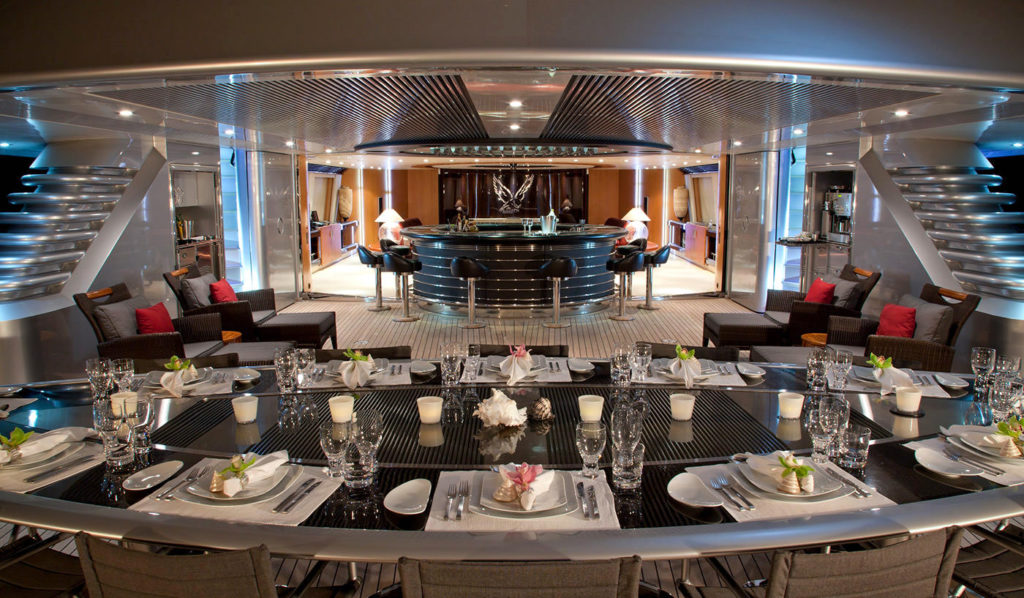
The yacht is magnificent not only outside, but also inside. She is capable of accommodating 12 guests in 6 luxurious guest cabins, decorated with a variety of materials and styles. Here and "cold" hi-tech with the active use of metal and glass, and "warm" inclusions of precious woods and genuine leather. Interior designers from the British company Ken Freiyokh sought to create as spacious rooms as possible, actively using natural light. And transparent doors and bulkheads visually increase the already considerable space.
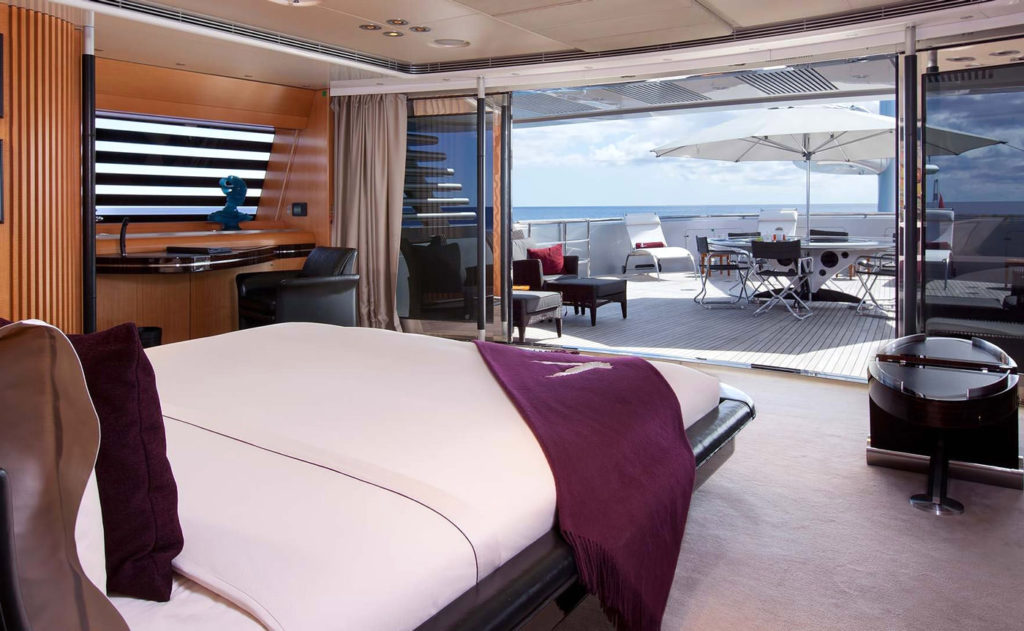
On board there was also room for a spacious dining room, two offices, a magnificent three-deck atrium and other rooms of various kinds. Interestingly, the mainmast is also an original part of the interior - its base is covered with transparent round panels and passengers can watch the rotation of the mast when the vessel is under sail.
The Maltese Falcon today
Perkins did not enjoy his "toy" for too long and in 2008 the yacht was put up for sale, and at a price that was clearly below the cost of its construction - 115 million euros. This fact once again convinced skeptics of the failure of the project, which eventually disappointed its owner. Like it or not, it is not known, the reasons for the sale are not reported, but since 2009 the Maltese Falcon has been owned by Pleon Limited and is used as a charter yacht. The rental price is 350,000 euros per week and many rich people are willing to take the opportunity to relax on board one of the most unusual yachts of our time. She is mainly used for cruises in the Mediterranean and Caribbean, but occasionally travels to other destinations.
Sokol is still in the top five largest sailing yachts in the world, taking 5th place. However, if you measure only by the length of the hull or by the waterline, not taking into account the bowsprit, then the place will no longer be 5th, but even 3rd. After all, the length of the classic sailboats Eos and Athena, occupying 3rd and 4th places, is indicated with a bowsprit, which, according to some experts, is not entirely correct.
Over the years of its existence, the Maltese Falcon has won almost two dozen different prestigious awards, both for design and technical innovation. This yacht invariably attracts the closest attention in all ports, both from professionals and ordinary people.
Despite the fact that the project caused a lot of controversy, in 2016 the Dutch shipbuilder Oceanco built Yacht Black Pearl, with a length of 106.7 meters, which is today the largest DynaRig rigged sailboat in the world, with a total sail area of 2900 sq. m. She also ranks second in the ranking of the most largest sailing yachts in the world, second only to the yacht "A", with a length of 144.03 meters. The appearance of the Black Pearl is often cited as a counterargument to opponents of the Maltese Falcon, who consider DynaRig an ineffective solution.
Characteristics of the yacht Maltese Falcon
- Maximum length 88 m
- Width 12.6 m
- Draft 6 m
- Displacement 1240 t
- Height 58.2 m
- Sailing area 2400 sq.m
- Speed 16 knots
- Maximum speed 19.5 knots
- Passenger capacity 12+16 (team)

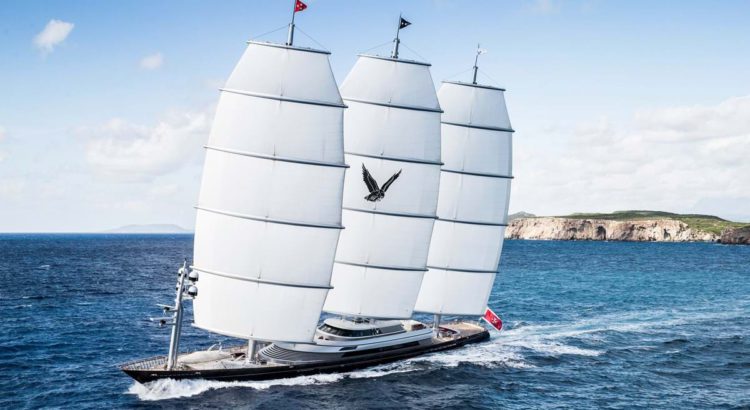
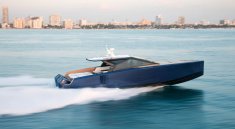

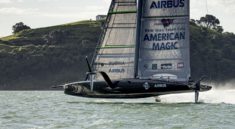
Speed max 19.5 knots. The Russian frigate Mir (St. Petersburg), recognized as the fastest sailing ship in the world, reaches speeds of up to 21 knots. He is already 35 years old.
The idea is good, but needs improvement. The “impressive electric motors” that set and retract the sails only work while they are being set or retracted, so the average energy consumption is low and can be from batteries, which, in turn, can be recharged from solar panels. Energy can also come from a water propeller, which, in this case, works not as a propulsion device, but as a generator. It would be possible to get energy from wind turbines, but they would spoil the appearance. Thus, only after a long calm would it be necessary to start the diesel engine.